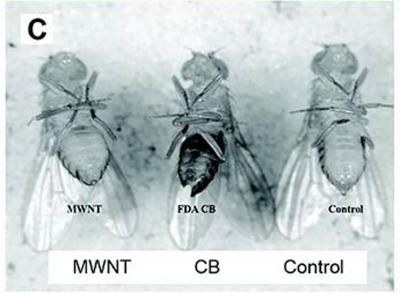Extremely tiny, hugely versatile
LMU chemists have demonstrated a simple way to load nanoglobules with light-absorbing organic molecules. The method could serve as the basis for the formulation of innovative sunscreens.

Azulene – a blue pigment that is derived from chamomile – is readily taken up into the micelles.
Heinz Langhals, LMU
Azulene – a blue pigment that is derived from chamomile – is readily taken up into the micelles. Picture: Heinz Langhals, LMU
Suntan lotions mitigate the harmful effects of the ultraviolet fraction of ambient sunlight by absorbing it before it reaches the skin. The chemicals that serve as sunscreens in these formulations are made up of dissolved organic molecules or inorganic colloidal suspensions of nanoparticles. The organic compounds used in these lotions are relatively lipophilic, i.e. they are preferentially soluble in fats. Hence they are normally used in conjunction with fat-rich media. “We have now found a way to incorporate lipophilic organic light-absorbing substances into organic nanoparticles that form colloidal suspensions in aqueous media,” says Professor Heinz Langhals of the Department of Chemistry at LMU. “These nanoparticles could therefore be utilized as the basis for the development of novel water-soluble sunscreens and other skincare products.”
The idea of loading organic nanoparticles with lipophilic molecules was an offshoot of work that Langhals and his team had done while designing experiments utilizing harmless reagents for demonstration purposes in chemistry classes. “We wanted to demonstrate the connection between the structural and optical properties of organic molecules using the simplest possible approach,” Langhals says. The nanoparticles are prepared simply by adding the tenside cocamidopropylbetain (CAPB, a fatty substance derived from coconut oil, and a common ingredient of shampoos) to distilled water and stirring vigorously. Because CAPB bears charged groups at one end while its other end is water-insoluble, manual agitation of the mixture creates an emulsion consisting of spherical droplets of the tenside suspended in the aqueous medium. In these “nanomicelles”, the hydrophilic ends of the tenside molecules interact with water, while the water-repellent tails cluster together within the droplets. “These particles can be thought of as minuscule soap bubbles with a diameter of significantly less than one-thousandth of a millimeter,” Langhals explains.
Micellar uptake of organic substances
The LMU researchers first incorporated azulene – a blue pigment that is derived from chamomile – into the nanodroplets simply by adding the compound to the emulsion and stirring the mixture. Azulene itself is insoluble in water, but it is readily taken up into the lipophilic micelles, and the aqueous suspension takes on a deep blue color. “This change makes for a very striking effect in demonstrations – and it can also be exploited for the development of novel cosmetics,” says Langhals: Azulene, which has anti-inflammatory properties, is already in use in oily aftercare lotions used to ameliorate the effects of sunburn. “With our azulene nanomicelles, it is now possible to manufacture fat-free personal-care products.”
As an alternative to azulene, the nanomicelles can also be loaded with naphthalene derivatives. Naphthalene is a structural isomer of azulene – they have the same chemical formula, but their constituents are linked together in different ways. In contrast to azulenes, naphthalenes are colorless and absorb UV radiation, so they effectively filter the UV out of the sunlight that reaches the skin. Incorporation of naphthalene derivatives or other UV-absorbing molecules into nanomicelles could therefore lead to the development of new types of sunscreen. “In contrast to inorganic nanoparticles, whose possible long-term effects on health and the environment are currently the subject of intense debate, organic nanomicelles should be biodegradable,” says Langhals. “While they have yet to be explicitly tested in this respect, we would expect them to precipitate in the uppermost layer of the epidermis and be sloughed off, thus releasing the organic substances they contain.”
Original publication
Most read news
Original publication
Heinz Langhals, Moritz Eberspächer, and Alexander Hofer; "Learning about Structural and Optical Properties of Organic Compounds through Preparation of Functional Nanomicelles while Avoiding Hazardous Chemicals or Complicated Apparatus"; J. Chem. Educ., 2015, 92 (10), pp 1725–1729
Topics
Organizations
Other news from the department science
These products might interest you

NANOPHOX CS by Sympatec
Particle size analysis in the nano range: Analyzing high concentrations with ease
Reliable results without time-consuming sample preparation

Eclipse by Wyatt Technology
FFF-MALS system for separation and characterization of macromolecules and nanoparticles
The latest and most innovative FFF system designed for highest usability, robustness and data quality

DynaPro Plate Reader III by Wyatt Technology
Screening of biopharmaceuticals and proteins with high-throughput dynamic light scattering (DLS)
Efficiently characterize your sample quality and stability from lead discovery to quality control

Get the chemical industry in your inbox
By submitting this form you agree that LUMITOS AG will send you the newsletter(s) selected above by email. Your data will not be passed on to third parties. Your data will be stored and processed in accordance with our data protection regulations. LUMITOS may contact you by email for the purpose of advertising or market and opinion surveys. You can revoke your consent at any time without giving reasons to LUMITOS AG, Ernst-Augustin-Str. 2, 12489 Berlin, Germany or by e-mail at revoke@lumitos.com with effect for the future. In addition, each email contains a link to unsubscribe from the corresponding newsletter.



























































